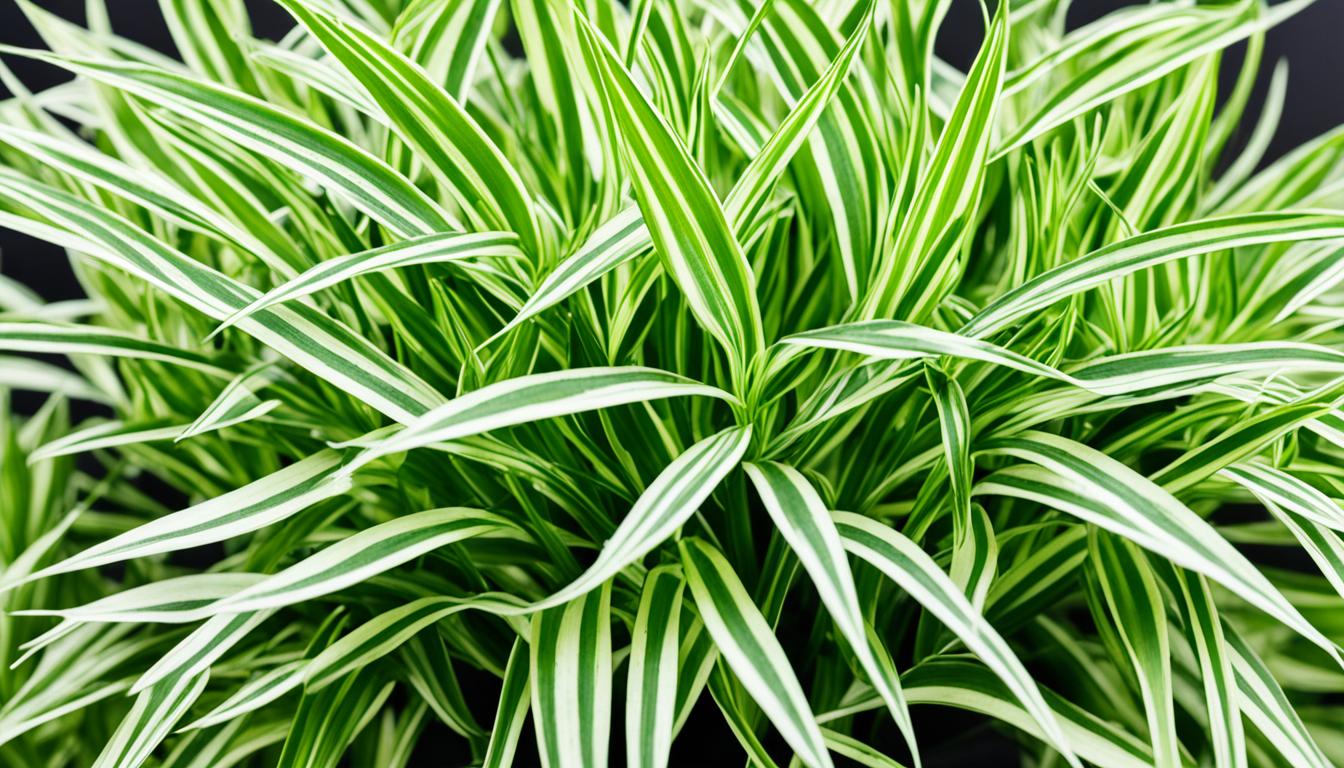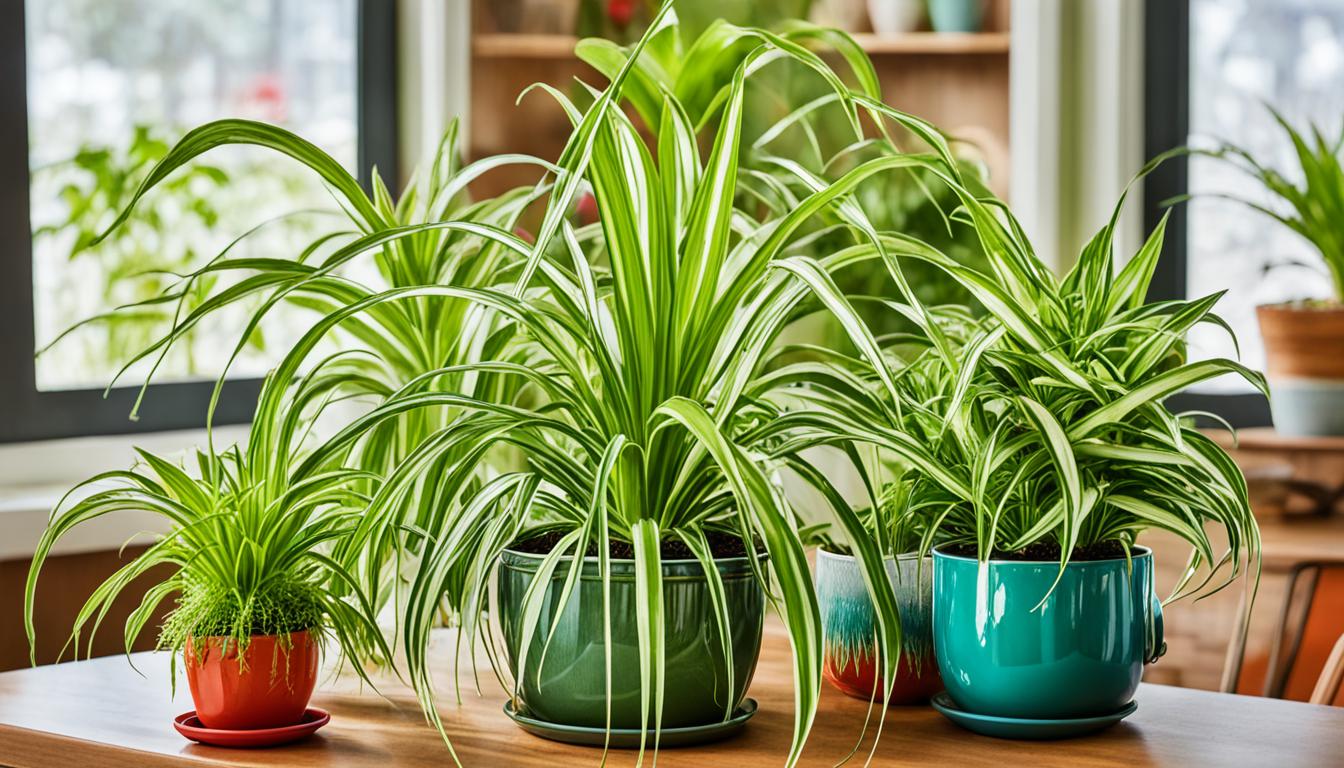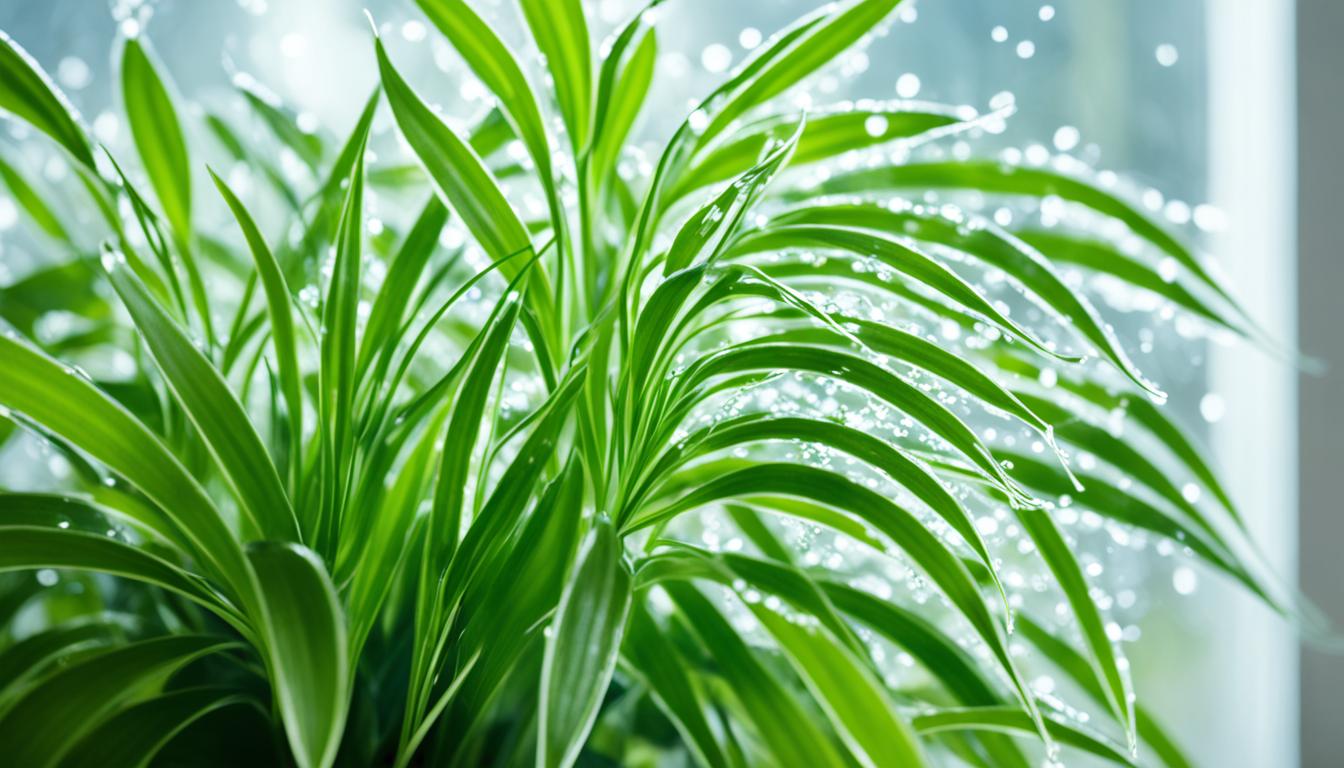The humble Bonnie Spider Plant is incredibly powerful. It can take away up to 95% of toxins from your home in just one day. This easy-to-care-for plant is a top pick for indoor spaces. Its curly leaves add a fun touch to any room.
This plant comes from Africa and is in the Asparagaceae family. It fits well in different light settings. So, whether you know a lot about plants or are just starting, this one is perfect. It looks great and doesn’t need much attention.
Key Takeaways
-
The Bonnie Spider Plant is a unique and charming variety of the classic Spider Plant, known for its compact size and curly, cascading leaves.
-
Originating from Africa, this houseplant belongs to the Asparagaceae family and is an excellent air-purifying plant.
-
The Bonnie Spider Plant is highly adaptable and able to thrive in a range of lighting conditions, making it a versatile choice for indoor spaces.
-
With its low-maintenance care requirements and pet-friendly nature, the Bonnie Spider Plant is an ideal choice for both novice and experienced plant enthusiasts.
-
This plant’s striking appearance and ability to remove toxins from the air make it a popular and desirable addition to any home or office.
Introducing the Bonnie Spider Plant
The Bonnie Spider Plant is a special type of the well-known Spider Plant. Its real name is Chlorophytum comosum ‘Bonnie’. This plant comes from Africa. It is part of the Asparagaceae family, just like the Asparagus Fern and other favorite houseplants.
Origins and Taxonomy
The Bonnie Spider Plant is closely related to the regular Spider Plant. They are both in the same plant family. This one comes from Africa. It has been specially taken care of to look different and to be great for homes.
Unique Features and Appearance
People love the Bonnie Spider Plant for how it looks. It is small and has leaves that twist and fall down. The leaves are long and thin, and they feel thick and look shiny. Some have lines of green, white, and yellow on them. The plant has green stems and grows in a circle. It might even have pretty white flowers that look like stars if you take good care of it.
Variety Differences
The Bonnie Spider Plant is not like other spider plants because of its style. It looks different from the usual green and variegated ones. People who like plants indoors really like this special, short plant.
Bonnie Spider Plant Care and Growing Conditions
To keep your Bonnie Curly Spider Plant healthy and looking good, you need to know its needs. This includes the right light, water, temperature, and soil. It’s essential to meet these needs to help the plant flourish in your home.
Lighting Requirements
The Bonnie Curly Spider Plant can do well in different light settings. It grows best in bright, indirect light but can handle less light too. In darker areas, it might grow slower but will still be healthy. Watch how it reacts to light to keep it looking its best. Too little light means it might stretch out or produce fewer spiderettes. Too much can cause its leaves to turn yellow. Placing it by an east or south window is perfect for getting the right amount of light.
Watering Needs
This plant likes to stay a bit moist but not soggy, keeping it up is easy. Let the soil dry a bit between waterings to prevent drowning the roots. In summer, water it when the top soil is dry. Cut back on watering in winter to avoid overwatering. It’s important to use soil that drains well. This stops the roots from getting too wet.
Light and Watering Needs
| Light Requirement | Watering Frequency |
| Bright, indirect light | When the top inch of soil is dry |
| Tolerates low light | Reduce watering in winter |
Ideal Temperature and Humidity
The Bonnie Curly Spider Plant does best in normal home temperatures from 65°F to 75°F. It doesn’t like sudden cold or hot shifts, so keep it away from drafts. For humidity, it prefers levels found in most homes. If your home is dry, give the leaves a light mist or put it on a tray of pebbles and water to boost moisture.
Soil and Fertilizer Preferences
It does great in soil that drains well and is full of nutrients. A mix of potting soil, perlite, and compost is perfect. But stay away from heavy soils that trap water. To help it grow, give it a water-soluble fertilizer every 4-6 weeks in the growing season. This keeps the plant happy and green.
Ideal Soil Mix
| Component | Purpose |
| Peat Moss | Moisture retention and nutrients |
| Perlite | Drainage and aeration |
| Compost | Organic matter and soil structure |
Propagating and Repotting Bonnie Spider Plants
The Bonnie Spider Plant is special because it grows new plants from itself. It grows tiny versions of itself that hang by thin threads, looking like tiny spiders.
Propagating from Offsets (Spiderettes)
When the plants get these mini copies, you can make new Bonnie Spider Plants. You just cut off the smallest plant with clean scissors. Make sure to leave a bit of stem from the mother plant on it. Then, put this in dirt that drains well and keep it moist. Soon, you will have more Bonnies to enjoy or give to others.
Dividing and Repotting Mature Plants
As your plant gets bigger, it may need more room or new soil. To do this, take the plant out carefully, being gentle with the roots. Separate it into smaller parts, each with good roots and a few leaves. Put these parts in new soil that’s good for drainage. The pots should be a bit bigger than before. This makes your plant healthier and gives you more plants.
Bonnie Spider Plant’s Air-Purifying Abilities
The Bonnie Curly Spider Plant looks great and does a lot for the air. NASA says it can clean up to 95% of toxic stuff from the air in just a day. This plant is good at taking in bad air and making it clean, thanks to a process known as phytoremediation.
The plant is especially good at getting rid of formaldehyde, xylene, and carbon monoxide from the air in our homes. Adding it to your home or office can help you breathe better. This means you are doing a small part to make your area cleaner and healthier.
Decorative Uses and Display Ideas
The Bonnie Curly Spider Plant isn’t just for clean air. It shines in decor too. It fits in hanging baskets, unique pots, and terrariums, adding beauty indoors.
Hanging Baskets and Trailing Displays
With its arching leaves, the Bonnie Curly Spider Plant is great in hanging pots. Its curly leaves look elegant as they hang. And the tiny spiderettes hanging down look whimsical, like a spider, making it stand out.
Terrariums and Dish Gardens
The Bonnie Spider Plant fits well in small spaces like terrariums. Its green, arching leaves add a natural touch. Being okay with less light, it’s perfect for these mini-worlds.
Unique Containers and Planters
Use the Bonnie Spider Plant in all sorts of pots, not just hanging ones. Try different materials and shapes. This lets you make a special look that suits your style.
Troubleshooting Common Issues
Identifying and Treating Pests
The Bonnie Curly Spider Plant is easy to take care of, but sometimes it gets bugs. Spider mites, aphids, and mealybugs might show up. Check the plant often for signs like webbing, small bugs, or white cotton stuff. You can remove bugs by wiping the leaves with a wet cloth. For heavy infestations, use a safe insecticidal soap or neem oil. Good air flow and proper watering also stop pest problems.
Addressing Leaf Discoloration and Drooping
If the leaves of your Bonnie Spider Plant start to change color or wilt, it’s a sign something is wrong. Too much or too little water can both cause this. Make sure to water the plant only when the soil is a bit dry. It should get the right amount of light, too. If these steps don’t help, try changing its spot or watering less or more.
Conclusion
The Bonnie Spider Plant is a special houseplant. It’s easy to take care of and has unique curly leaves. It’s great for purifying the air and safe for pets. This makes it perfect for anyone who loves plants.
Are you looking to make your home cozier? Maybe you want a plant that’s easy to keep alive and cleans the air. The Bonnie Spider Plant is a great choice. It grows quickly and does well in different light conditions. Plus, it looks beautiful with its variegated leaves and delicate white flowers.
Why not get a Bonnie Spider Plant for yourself? It will bring joy and cleaner air to your home. This lovely plant makes any home feel more welcoming.
<div class="quiz-container">
<h1> Growing the Beautiful Bonnie Spider Plant Indoors </h1>
<form id="bonnie-spider-plant-quiz">
<div class="question">
<h2>1. What is the ideal light condition for a Bonnie Spider Plant?</h2>
<label>
<input type="radio" name="q1" value="a"> Direct sunlight ☀️
</label>
<label>
<input type="radio" name="q1" value="b"> Low light
</label>
<label>
<input type="radio" name="q1" value="c"> Bright, indirect light
</label>
<label>
<input type="radio" name="q1" value="d"> Full shade
</label>
</div>
<div class="question">
<h2>2. How often should you water a Bonnie Spider Plant?</h2>
<label>
<input type="radio" name="q2" value="a"> Daily
</label>
<label>
<input type="radio" name="q2" value="b"> Once a week
</label>
<label>
<input type="radio" name="q2" value="c"> When the top inch of soil is dry
</label>
<label>
<input type="radio" name="q2" value="d"> Once a month ️
</label>
</div>
<div class="question">
<h2>3. What type of soil is best for a Bonnie Spider Plant?</h2>
<label>
<input type="radio" name="q3" value="a"> Sandy soil ️
</label>
<label>
<input type="radio" name="q3" value="b"> Clay soil
</label>
<label>
<input type="radio" name="q3" value="c"> Well-draining, rich soil
</label>
<label>
<input type="radio" name="q3" value="d"> Rocky soil
</label>
</div>
<div class="question">
<h2>4. How can you promote healthy growth in a Bonnie Spider Plant?</h2>
<label>
<input type="radio" name="q4" value="a"> Fertilize monthly
</label>
<label>
<input type="radio" name="q4" value="b"> Keep in direct sunlight ☀️
</label>
<label>
<input type="radio" name="q4" value="c"> Water frequently
</label>
<label>
<input type="radio" name="q4" value="d"> Prune regularly ✂️
</label>
</div>
<div class="question">
<h2>5. How do you know if a Bonnie Spider Plant needs repotting?</h2>
<label>
<input type="radio" name="q5" value="a"> Yellowing leaves
</label>
<label>
<input type="radio" name="q5" value="b"> Roots growing out of the pot drainage holes
</label>
<label>
<input type="radio" name="q5" value="c"> Stunted growth
</label>
<label>
<input type="radio" name="q5" value="d"> All of the above
</label>
</div>
<button type="button" onclick="checkAnswers()">Submit</button>
</form>
<div id="results"></div>
</div>
<style>
.quiz-container {
font-family: Arial, sans-serif;
max-width: 600px;
margin: auto;
padding: 20px;
border: 2px solid #4CAF50;
border-radius: 10px;
background-color: #f9f9f9;
}
h1 {
text-align: center;
color: #4CAF50;
}
.question {
margin-bottom: 20px;
}
label {
display: block;
margin: 5px 0;
}
button {
display: block;
width: 100%;
padding: 10px;
background-color: #4CAF50;
color: white;
border: none;
border-radius: 5px;
cursor: pointer;
}
button:hover {
background-color: #45a049;
}
#results {
margin-top: 20px;
text-align: center;
}
</style>
<script>
function checkAnswers() {
const answers = {
q1: 'c',
q2: 'c',
q3: 'c',
q4: 'a',
q5: 'd'
};
let score = 0;
const form = document.getElementById('bonnie-spider-plant-quiz');
const results = document.getElementById('results');
const formData = new FormData(form);
formData.forEach((value, key) => {
if (value === answers[key]) {
score++;
}
});
results.innerHTML = `<h2>Your Score: ${score}/5</h2>`;
if (score === 5) {
results.innerHTML += `<p> Excellent! You are a Bonnie Spider Plant expert! </p>`;
} else if (score >= 3) {
results.innerHTML += `<p> Good job! Keep up the great work in caring for your plants! </p>`;
} else {
results.innerHTML += `<p> Keep learning and your Bonnie Spider Plants will thrive! </p>`;
}
}
</script>
Growing the Beautiful Bonnie Spider Plant Indoors
Relevant Articles:
Source Links
bonnie-spider-plant


